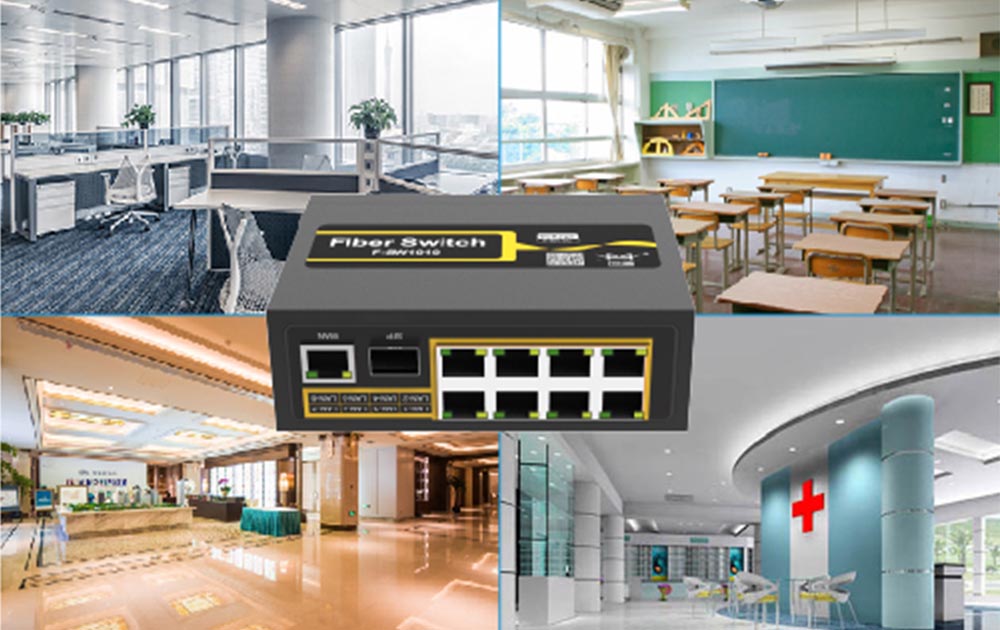The optical fiber media converter is a network interconnection device that realizes the regeneration amplification and wavelength conversion of optical signals, and the optical module is a network interconnection device that realizes the conversion of photoelectric signals. Although the optical module and the optical fiber media converter both adopt the principle of photoelectric conversion , can realize photoelectric conversion, but the functions and applications of the two are quite different and cannot be replaced by each other. This article will introduce the difference between optical modules and fiber media converters in detail.
1. Fiber Media Converter VS Optical Module
Optical fiber media converter, also known as photoelectric wavelength converter or optical amplifier repeater, is an optical fiber media converter that integrates transmitter and receiver. It can extend network transmission by converting wavelength and amplifying optical power. It has the functions of balanced amplification, timing extraction and identification of regenerated optical signals. Today, the common fiber media converters on the market are 10G/25G/100G, of which 10G/25G fiber media converters can realize fiber conversion (such as dual-fiber unidirectional conversion to single-fiber bidirectional), fiber type conversion (multimode fiber conversion) It is a single-mode fiber) and optical signal enhancement (amplification regeneration, shaping and clock retiming are achieved by converting ordinary wavelength optical signals to ITU-T-defined wavelengths); usually used in conjunction with EDFA fiber amplifiers and DCM dispersion compensators, widely used It is used in metropolitan area network, WDM network, especially in ultra-long distance DWDM network. The 100G fiber media converter (ie 100G multiplexed fiber media converter) is mainly developed for 10G/40G/100G transmission to flexibly convert different optical interfaces, that is to say, the 100G fiber media converter can support 10GbE, 40GbE and 100GbE. Flexible combination, available in enterprise network, campus network, large data center interconnection, metropolitan area network and some remote applications.
As a communication device that transmits and receives optical signals, optical modules are often used in optical fiber communication systems such as data centers, enterprise networks, cloud computing, and FTTX. Usually, optical modules support hot swap and can be used in module slots of network equipment such as network switches and servers. There are many types of optical modules on the market, such as 1G SFP, 10G SFP+, 25G SFP28, 40G QSFP+, 100G QSFP28, 400G QSFP-DD optical modules, etc. They are usually used with different types of fiber jumpers or network cables to achieve different distances. Network transmission, the transmission distance ranges from 30 meters to 160 kilometers. In addition, BiDi optical modules can transmit and receive signals through a single optical fiber, which effectively simplifies wiring, increases network capacity, and reduces wiring infrastructure costs. Similarly, WDM series optical modules (ie CWDM and DWDM optical modules) can also multiplex signals of different wavelengths on the same optical fiber for transmission, which is common in WDM/OTN networks.
2. The difference between fiber media converters and optical modules
It can be seen from the above that both optical modules and fiber media converters can convert electrical signals into optical signals, but the difference between the two is:
2.1 The optical module adopts a serial interface, which can transmit and receive signals inside the optical module; while the optical fiber media converter adopts a parallel interface, which must be matched with an optical module to realize signal transmission. Among them, the optical module on one side is used for transmitting signal, and the optical module on the other side is used to receive the signal.
2.2 Although optical modules can realize photoelectric conversion, optical fiber media converters can realize photoelectric signal conversion from different wavelengths.
2.3 Although the converter can easily handle low-rate parallel signals, its size and power consumption are larger than that of optical modules.
In simple terms, the fiber media converter can be regarded as a disassembled optical module, but it completes the long-distance WDM network transmission that the optical module cannot achieve.
Summarize
In conclusion, fiber media converters and optical modules are still different in nature, especially in terms of function and application. Optical modules can only convert electrical signals into optical signals, and fiber media converters can convert different types of signals, including fiber conversion, fiber type conversion, and wavelength conversion, to achieve longer-distance network transmission.




















